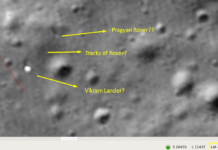Chandrayaan-2: Lunar night falls, Vikram moon lander & Pragyan expected to go silent forever
Bengaluru: India’s moon lander Vikram is lost forever. With a long and biting cold with temperatures that can dip to beyond minus 200 degrees setting in, the 1471 kg Vikram with 27 kg Pragyan rover in its belly will be left desolate and powerless as its solar panels would not be able to recharge.
Vikram had crash-landed at the beginning of the lunar day which is equivalent to 14 earth days. It was destined to live only for those two weeks even if it had made a soft landing. ISRO scientists here tried desperately to wake up Vikram as the lunar days were ticking by. With that window period now gone, chances of establishing a connection are almost nil.
By the time the next lunar day dawns, the moon lander would be as good as dead.
ISRO had a faint hope that despite a crash landing on September 7, at least some of its onboard computer systems would beep back a message. That was not to be. This has given credence to the speculation that the lunar craft had died in the crash itself.
According to sources and widely quoted in the media, it was an error in the automatic landing programme (ALP) that caused Vikram to go out of control and crash-land.
Latest information coming out of ISRO says that Vikram had almost nose-dived on the lunar surface at a speed of more than 200kmph. In such a speed, the onboard systems would have gone to smithereens.
The team analysing the crash seems to have come to the conclusion that Vikram had turned upside down and the thrusters that were supposed to act as brakes, became boosters which speeded up Vikram’s crash.
But ISRO scientists are unanimous that Vikram has not been damaged beyond recognition. It is lying on its side or topsy-turvy.
Had it crashed on its legs, the ‘boots’ would have taken the impact and some of the onboard systems would have survived.
According to sources, the reason for the crash could have been an error in the crucial landing program written by a team at the UR Rao Satellite Centre, Bengaluru. The programme is now under scrutiny and teams are combing through reams of coding that went behind the soft-braking period and the lander’s descent.





















































